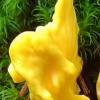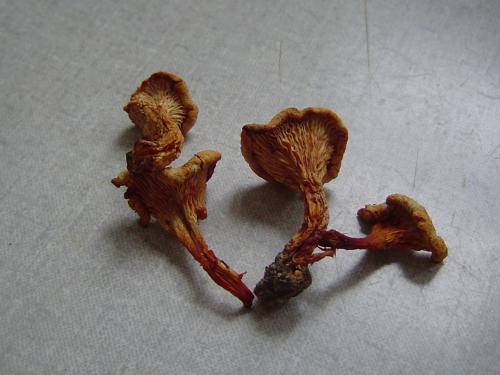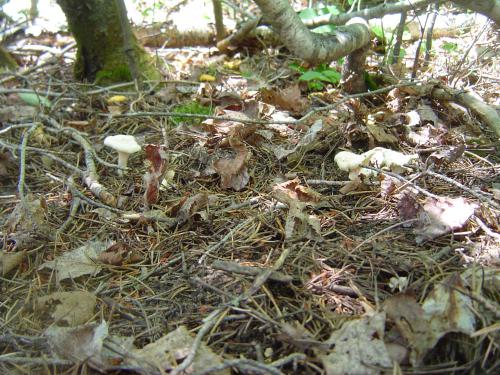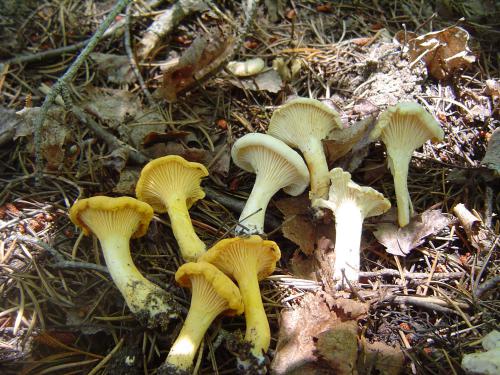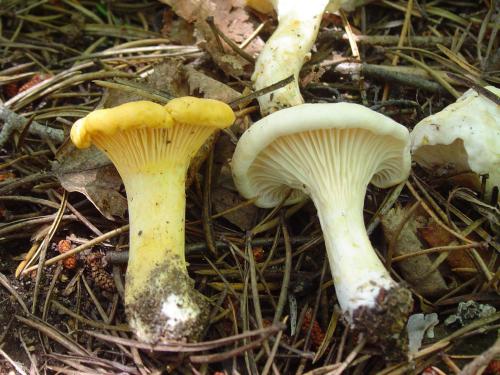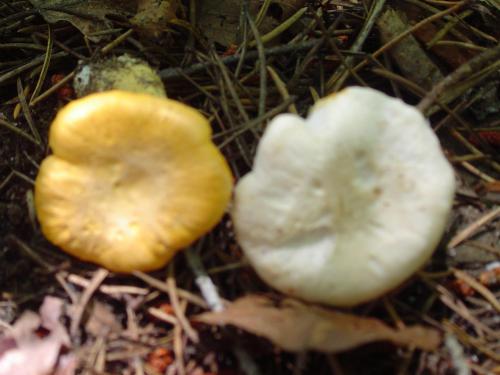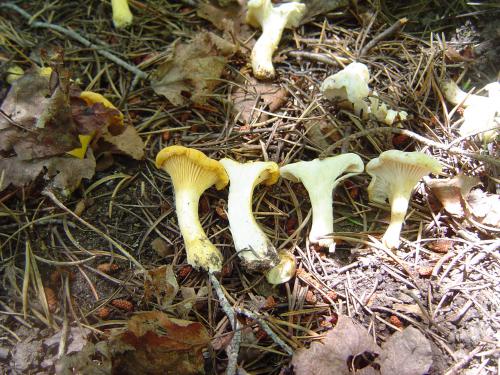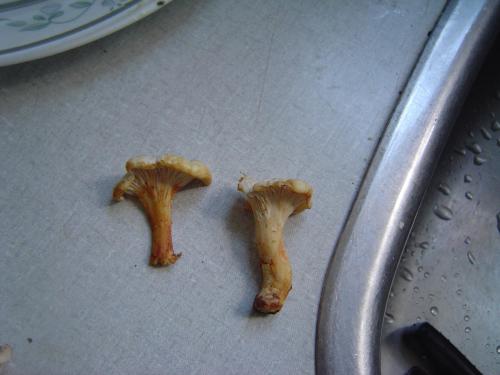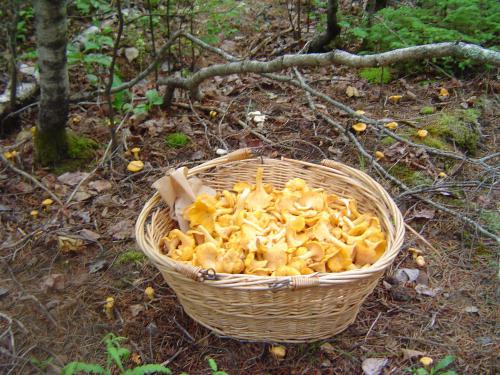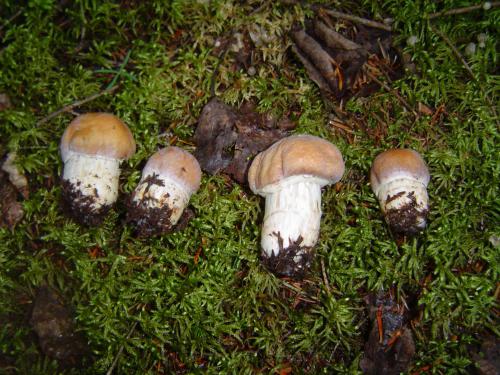-
Posts
93 -
Joined
-
Last visited
Everything posted by 1left
-
Thanks, I appreciate the insights.
-
Found a few of these today most on small dead Aspen but also on beech, usually attached at the base at ground level. The stem is very tough cut lengthwise but tender cut across. Thin yellow layer under the cap with the flesh white. Stem seems to bruise faint yellow. I am assuming the larger mushroom with the yellow gills is a mature version of the other mushroom, the cap scabs are gone though there are still some on the stem. Any ideas on the ID? Maybe Pleurotus dryinus?
-
Thanks Dave, the photo was taken within a minute of the slice and nothing blue developed before or after that time.
-
I sent in a photo of this mushroom last Sept and found one again today in early July here in New Brunswick Canada. Last year Dave W suggested possibly B pallidoroseus or B bicolor or B bicoloroides based on one not so great photo. This time again there is no noticeable beef scent. Though we at the house agree it has a beer aroma oddly. I will dry this one to see if it changes scent some. In one photo we can see the thin pore layer which may narrow the possibilities. Thanks for having a look PS I forgot to mention a 1/4 to 1/2 inch noticeable reticulated at the top of the stem.
-
Thanks Dave W, I appreciate the info on these. Oh, if I run into B pallidoroseus someday, do you know if they hold the beefy scent when dried?
-
Didn't notice any scent to them Dave W. The large caps and unusual flat sided stems were standouts, the stems seemed short as well.
-
I don't explore hardwood areas in August very often so here are a few mushrooms I never gathered before until a few hours ago 1 & 2 Should be the American Caesar mushroom Amanita jacksonii, surprised to see it this far north in New Brunswick Canada. There were no Oak trees here, these were under beech and birch. 3 & 4 are the same mushroom which were around a well rotted mountain birch, these (thick 2 inch) (long 6 inch) stem mushroom with large caps are an interesting mushrooms gills are a shade darker than stems but still quite white, I haven't done a spore print yet. Many of the mushroom are attached to each other at the base, scent pleasant. The base of the stem seem solid to the ground like they are attached to a buried stump or wood. 5 Large capped bolete around 9 inches across, many stem v shaped with flat sides, base fussy yellow white, above almost purple then light pink red near the top of stem, pores go a 1/8 inch down stem, pore layer stains green blue quick, flesh either doesn't turn color or very faintly does, flesh yellow, cap pinkish red. mixed woods beech birch some conifers. 6 Think this 3 inch cap with hollow stem, dark brown stem and cap, light yellow pores on older mushrooms must be the Chestnut Bolete. Most interested in what you think about 3, 4, 5. Thanks 1left
-
You have some Interesting experiences with blushers Monstarules, thanks for your input. I suspect similar things occurring in areas where these mushrooms appear together and if Hypomyces hyalinus is common as well folks are probably eating some slightly to fully parasitized blushers if it is a local custom in rural areas. I have no proof of this happening though, it may or may not be the case in latin America where blushers are commonly eaten, though I am only speculating here as I don't known how far south Hypomyces hyalinus goes. A few more photos on the blusher/Hypomyces hyalinus situation in my area in New Brunswick. These photos are from blushers growing under birch and aspen. I have only eaten blushers and have not tried any I consider parasitized.
-
Tasso your comment is necessary as safety is the #1 most important concern and frankly I often wait several years before trying mushrooms like this one which are on the outer most limits, I do a lot of research and weigh things very carefully, though I will explain further - If your Hypomyces hyalinus mushroom blushes as the mushrooms in the photo blush at the base when cut you can rule out all but A amerirubescens and A flavorubescens. In my area oak trees are rare and not present where I look for blushers which is in conifers forest especially under jack pine, A flavorubescens is common under oak and very rare with conifers, which leaves me with a lot of Amanita amerirubescens with the majority covered by Hypomyces hyalinus, much of N.A doesn't have this situation as I suspect most blushers are found under oak in the eastern US which creates more concern for misidentification. The main issue I have with my local H hyalinus as an edible is the small odds of it being on A flavorubescens which seems to be of (unknown) edibility and also no one is stepping forward to state they eat this mushroom. I only see vague statements on its edibility while on Amantia amerirubescens. In parts of Mexico their blushers are commonly eaten and sold at markets though I can't see any info whether H. hyalinus is eaten or present where the Mexican blushers are gathered. The best known Hypomyces the Lobster mushroom is a popular edible and sold in many markets in Mexico, so I am curious what is happening with Hypomyces hyalinus in areas blushers are commonly eaten. I suspect there may also be a few small pockets within the US where blushers are popular though not turning up much info so far. Right now I'm miles away from eating Hypomyces hyalinus but in conifer forest where H. hyalinus blushes at the base when cut and all surrounding mushrooms are uninfected Amanita amerirubescens this becomes interesting. I will continue to dig around the net a bit to see what other folk's views are on this mushroom and if any will discuss their experience in edibility.
-
Dave W they have no bluing on pores, if you peel the cap it is brownish below, there are a few other mushrooms relatively close by including Hemileccinum subglabripes, Amanita muscaria and also the ghost plant Monotropa uniflora. The main trees are large poplars and the reticulate is very noticeable and covers most of the stem, these kings usually only fruit in July & Aug, haven't seen them later on. A hardwood summer king maybe the best way to go with this one. Most of our other local kings around here appear in Sept under norway spruce and pines and other native spruce. thanks
-
In my area of New Brunswick Canada around 80% of our blusher mushrooms are covered by Hypomyces hyalinus and the other 20% are most often bug infested when they pop. Investigating a large cluster of blushers today I noticed the nice thick Hypomyces hylalinus blushers were bug free and had a solid and also moist texture inside, so of course I'm wondering if anyone has eaten these on this forum? I know Hypomyces hyalinus can be on a few other Amanita mushrooms so this is a edgy subject but one I think is worth discussion.
-
Been curious of the correct name of this summer king-like Bolete for awhile now. This one as a rule is quite small though one was over 8 inches across. These were in damp sandy woods with mostly poplar, young red maple and a few spruce around. Many were at the base of small trees and had bend stems. Caps as a rule were darker red brown when young fading to tan with age. Interested in what you suspect these are? thanks
-
I see looking a bit deeper the Arabitol levels in False Chanterelle mushrooms may be a problem for some folks. Seems like a mushroom which may be only safe for some and possibly extra processing involved which is fine if the food turns out to be good? I have found a plentiful source if things pan out. If the taste is poor that would end the interest.
-
Found a lot of Hygrophoropsis recently in a mature spruce forest and I am now considering them for the table. Anyone with first hand experience with False Chanterelle as an edible? Does anyone dry them?
-
Thanks John and Dave W, I've sliced the chicken of the woods thicker and made a few sandwiches, real nice edible, if it is even better when less mature, wow.
-
First time exploring an area where there were a few mature Red Oaks which are rare in my neck of the woods. In my Bolete book Retiboletus ornatipes seems the best fit, but you folks familiar with oak tree boletes may have other suggestions? Added a photo of my first time collection of Laetiporus sulphurous as well, this was a nice surprise, ate a small piece last night fried with garlic and found the texture was meaty, like a powdery chicken. I cut thin 1/4" pieces and may have over cooked it fried for 10 minutes, still found it a good edible. May slice wider pieces next try.
-
These small white covered Chanterelles have been in a paper bag since my last reply on the 19th and now look like typical New Brunswick, Canada yellow/orange Chanterelles once fully dried, remember when fresh I rubbed the stems on all 4 to see if the white would come off so bruising could be expected though the gills were not touched and still yellowed during the drying. I seen a few other spots last year with again small groups of 4 or 5 white mushrooms surrounded by large numbers of yellow Chantys which I have not got to yet this year, I'll post again if something interesting is to add. Also I did place some Ferrous Sulfate on both yellow and white Chantys on the out and inside flesh and got a bluish reaction on all the chantys.
-
Thanks everyone, here are some new photos. I've known this Chanty patch for15 years and this is the first year for any white ones. Today the humid is down and cooler and the covering isn't damp and will not rub away like it did in hot humidity, the flesh rubs off first with the white coating, internal flesh idenitical on both chantys, they will bruise and over time (15 minutes darken) like a typical yolk colored Chanterelle which is roughed up. I've saved a few of these whitish chantys and may mail them to a mycologist as this seems quite interesting at least to me. -- Hypomyces, mold, something else?
-
Thanks John, I was surprised after reading your reply just how many different Hypomyces may be out there, one of my favorite websites list 12 Hypomyces, mostly mycoparasites of Russula, Lactarius, Amanita and Boletus. They had none listed for the Chanterelle family, but it may be just a matter of time.
-
I've heard mention of the half white chanterelle in the last few years, but a few of the chanterelles I'm finding on humid days seem to at least on young chanterelles to be more of a moist white powder covering the yolk color beneath. I'm noticing even Cortinarius caperatus is powdery as well in the humidity, I known young Gypsy mushrooms have a bloom but this is heavier and is on the stem and gills. It seems almost like a milder version of the Amanita Mold which is out in force here as well. Has anyone also notice this lately, I'm finding these in New Brunswick Canada. Unfortunately I didn't get any photos to show rubbing the stems to show the powderiness of the covering.
-
I've heard mention of the half white chanterelle in the last few years, but a few of the chanterelles I'm finding on humid days seem to at least on young chanterelles to be more of a moist white powder covering the yolk color beneath. I'm noticing even Cortinarius caperatus is powdery as well in the humidity, I known young Gypsy mushrooms have a bloom but this is heavier and is on the stem and gills. It seems almost like a milder version of the Amanita Mold which is out in force here as well. Has anyone also notice this lately, I'm finding these in New Brunswick Canada. Unfortunately I didn't get any photos to show rubbing the stems to show the powderiness of the covering.
-
Found a few other Russula mushrooms tonight. Ones in the first photo where in conifer area, may be R brunneola or R mustelina or ?, they taste mild and I ate some last year, so these I'm comfortable with as a tasty edible. Second and third photo is a delicate little one with a slender long stem, soft and flexible cap shades violet, brown and yellow, also mild taste, not sure if I'll try this one without a bit more research, found in beech, birch and hemlock area Fourth photo probably R compacta as it has firm robust stem on the larger ones, fishy smell, this one I'm not going to experiment with as an edible, found in conifers.
-
Thanks Dave W, This one in the photos is a top notch edible, pretty confident I can ID it in the field now. It may be R paludosa or something else, either way it is an A1 edible pan fried crisp in butter, pinch of salt. Oh and the conifer brown cap Russula (probably R mustelina) you helped me with last year is another excellent edible I should be gathering again soon. These Russulas like the more famous R xerampelina are just plain good, seems you do not need to dress them up much to make them tasty.


